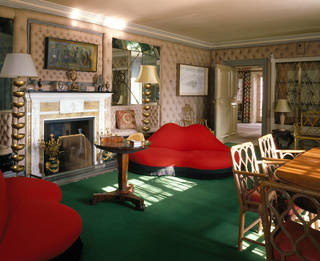The Mae West Lips sofa is one of the most important examples of modern furniture ever produced, and a triumphant expression of Surrealism. It is the joint creation of leading Surrealist artist Salvador Dalí (1904 – 89) and his British patron, Edward James (1907 – 84).
In 1935 Salvador Dalí, arguably the most famous of the Surrealist artists at the time, met a kindred spirit in the British collector and poet Edward James. James was Britain's most distinguished supporter of the Surrealist movement, and the pair struck up a deep friendship, with James becoming a collector of Dalí's work. In 1936 Dalí stayed with James at his London home, where they developed a number of ideas for Surrealist objects and furniture. It was James who suggested that they create a sofa based on Dalí's work, Mae West's Face which May be Used as a Surrealist Apartment (1934 – 35), which sees the scarlet lips of the Hollywood sex-symbol Mae West reimagined as seating for a fantastical room-setting.

Two years later James and Dalí produced the outlandish sofa design for James' own country home, Monkton House, on his family estate in West Sussex. The house was originally designed by architect Edwin Lutyens in 1902, but in the mid-1930s, James had set about redecorating it in an attempt to create 'a complete Surrealist house', with the help of architects Christopher 'Kit' Nicholson and Hugh Casson, as well as decorator Norris Wakefield. The refurbishment combined James' taste for Victorian, Edwardian and Surrealist design, and was the only house of its kind in Britain.
James had a pair of bright red Mae West Lips sofas created specially for the dining room at Monkton. In total he commissioned and supervised the construction of five different versions of the sofa, each in different fabrics, (a hot-pink satin version was described by James as "too flashy"). But the two red upholstered sofas, with black wool fringing and green, larvae-shaped applique details, were the only ones made for a specific interior scheme by James. They sat either side of the fireplace, and were complemented by specially woven carpets and black-fringed pelmets, which James said were designed "to look like the embroidery upon the epaulettes of a picador or the breeches and hat of a toreador" – the highly decorative elements worn by Spanish bullfighters.

Beside each sofa stood another intentionally shocking Surrealist decoration – a standard lamp, each in the form of ten oversized golden champagne coupes, on a base decorated with gold ivy tendrils, berries and leaves. Six of the stacked champagne coupes cleverly conceal removable ashtrays. These whimsical Champagne standard lamps were the result of another collaboration between Dalí and James, and have recently been recognised as one of the most important examples of Surrealist lighting in Britain.

Thanks to their fascinating provenance, these objects have become iconic pieces of 20th-century furniture, and remain bold expressions of Surrealist design.
The lamps have been acquired for the museum's permanent collection with support from the National Heritage Memorial Fund, Art Fund and V&A Members, alongside the sofa, acquired with the support of V&A Members, Art Fund and a bequest from Derek Woodman.


